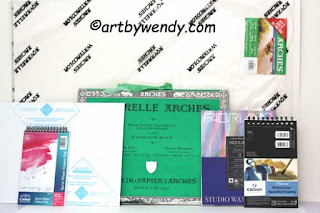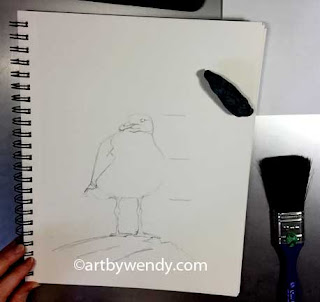NEW WORKS FROM THE STUDIO OF ART BY WENDY - Etsy Shop Now Open
Buried deep in your studio are Secrets. Waiting, yes waiting for you to find. They are little treasures that once found, will change your work forever. Their simplicity, Their magic, can turn the simplest art piece into something special.
My last post on painting backgrounds (see here) was all about lifting and glazing with watercolours. Lifting off a bit of colour can soften a spot, lighten a colour or just clean up an edge. Glazing is almost like magic changing a colour, to something no tube of paint can produce.
My little picture "A Peaceful Moment" grew out of my practice wash from the last post. That flower looked so lonely I felt it needed a butterfly. And the background wash worked out so well I decided to finish it.
That's when I realized my mistake.
I had not talked about the paper when I talked about the lifting and glazing. All Watercolour paper is not the same. Each type has its own strengths and weaknesses. Lifting and glazing is not for every type of watercolour.
The Secret to Success is about the paper.
My practice piece was done on a Student Grade 140lb hot press paper. Nice smooth surface for drawing with ink, holds the colours well for light glazing and gives intense colours. However, when it came to lifting, I was in trouble. The surface started to breakdown with even the softest touch of my scrubber brush. (see brush here) The Arches 140lb hot press paper, my normal paper, and the one I used for the main piece is stronger and will take that light scrubbing.
Here is the issue:
You want to practice but having the right paper does make the difference. It all depends on what you want to do:
The list goes on but let's start here. Disclaimer: I refer to the Artist Quality brands of paper most readily available here and that I have worked with. There are other good quality brands that may be more readily available in your area. The point is, check your paper, it may not be designed for what you want.
Paint Books, usually have 90-140lb paper in them: paint will lift off nicely, colours will be bright, they like drybrushing, nice surface for mixing ink drawing and watercolour; will buckle with a wet wash, hard to glaze colours as the under-painting will lift off easily.
Illustration Board: rigid, wont buckle, lovely surface for drawing on with ink first, shows the watercolours off well; doesn't take a really wet wash, likes dry brushing rather than glazing, not easy to lift off colour
Paint Blocks, Arches 140lb paper: strong paper for lifting, mixed media, wet washes. The block hold your paper flat so if it does buckle with the wet wash it will dry flat afterwards; hard to work on more than one picture at a time, surface is a little rough for detail ink drawing
Arches 140lb (300 gsm) Paper:
Cold Press: strong paper, takes a good wash, lifts and glazes, takes mixed media, easy to blend edges; rough surface for detailed drawing in ink, larger pieces will buckle if too wet,
Hot Press: great for drawing on with ink, brighter colours than Cold Press, good for layering colour with a dry brush; grabs the paint so not good for really wet washes, lift carefully as a more delicate surface than the Cold Press, hard to blend edges
Saunders 200lb Paper: excellent paper to work with, holds the water well for washes, stays wet longer for adding those soft details to the washes, doesn't buckle with ta wet wash; a slightly cheaper alternative to the 300lb paper, can be hard to find as many places only carry the 300lb paper.
Arches 300lb (638 gsm) Paper: the top of the line, does everything you want: lifting, glazing, wet washes, mixed media, wont buckle; very expensive for practicing, a little rough for detailed ink work,
Each type of Watercolour Paper holds its own bag of tricks. They are secrets waiting for you to discover. If you treasure them and use them wisely, your work will flourish. Ignore them to your own peril.
What is your favourite paper? What are its secrets that make it work for you?
Yes, I will get back to that more detailed background I promised but before that, we need to talk paint and Lifting and Glazing, Yes more secrets there. See you next week.
Etsy Shop now Open: WendyMouldsArt Come on In!!
All day Marketing Workshop - Let's Get Your Art Out There - March 5, 10-3pm. This is an opportunity to work with a small group focusing on ways that work for you, to market your art. Whether you are looking at full time or part Art Sales, there are effective, proven strategies that will get your work out the door. $70 Limited to 8 per session. Art by Wendy Studio/Gallery, N. Surrey, BC. REGISTER NOW with Wendy. Out of Towners & Skytrainers give me a call and we can set something up.
The Work of Art Conference Saturday, March 11, 9-4pm - 6 Sessions + Lunch, Arts Council of Surrey, Newton Cultural Center, Surrey, BC. Sessions focus on very specific Marketing Skills. My Presentation: Creating a Strong Online Profile, other sessions: Using the News media as a Promotional Tool, Grant Writing, Navigating the Publishing World, Business Plan Development. Great opportunity to learn some new skills. $25 Register by March 3, $40 after that. Call 604-594-2700 to Register.
Be sure to like and share my posts.
You won't miss a single one if you Follow by Email or Like my Facebook Page. Keep up with all the art events by joining my email list (see sidebar on my blog)
Buried deep in your studio are Secrets. Waiting, yes waiting for you to find. They are little treasures that once found, will change your work forever. Their simplicity, Their magic, can turn the simplest art piece into something special.
My last post on painting backgrounds (see here) was all about lifting and glazing with watercolours. Lifting off a bit of colour can soften a spot, lighten a colour or just clean up an edge. Glazing is almost like magic changing a colour, to something no tube of paint can produce.
 |
| A PEACEFUL MOMENT - 3 x 4 Ink & Watercolour |
My little picture "A Peaceful Moment" grew out of my practice wash from the last post. That flower looked so lonely I felt it needed a butterfly. And the background wash worked out so well I decided to finish it.
That's when I realized my mistake.
I had not talked about the paper when I talked about the lifting and glazing. All Watercolour paper is not the same. Each type has its own strengths and weaknesses. Lifting and glazing is not for every type of watercolour.
The Secret to Success is about the paper.
My practice piece was done on a Student Grade 140lb hot press paper. Nice smooth surface for drawing with ink, holds the colours well for light glazing and gives intense colours. However, when it came to lifting, I was in trouble. The surface started to breakdown with even the softest touch of my scrubber brush. (see brush here) The Arches 140lb hot press paper, my normal paper, and the one I used for the main piece is stronger and will take that light scrubbing.
Here is the issue:
You want to practice but having the right paper does make the difference. It all depends on what you want to do:
- wet washes that mix and move on the paper
- lifting and correcting
- glazing over your colours
- dry brushing
- mixing ink drawing or other mixed media
- working large
- working small
The list goes on but let's start here. Disclaimer: I refer to the Artist Quality brands of paper most readily available here and that I have worked with. There are other good quality brands that may be more readily available in your area. The point is, check your paper, it may not be designed for what you want.
 |
| Types of Paper: (Lto R) Paint Book, Illustration Board, Paint Block, more Paint Books, Behind: Sheets of Arches 140 lb & 300 lb paper. |
Paint Books, usually have 90-140lb paper in them: paint will lift off nicely, colours will be bright, they like drybrushing, nice surface for mixing ink drawing and watercolour; will buckle with a wet wash, hard to glaze colours as the under-painting will lift off easily.
Illustration Board: rigid, wont buckle, lovely surface for drawing on with ink first, shows the watercolours off well; doesn't take a really wet wash, likes dry brushing rather than glazing, not easy to lift off colour
Paint Blocks, Arches 140lb paper: strong paper for lifting, mixed media, wet washes. The block hold your paper flat so if it does buckle with the wet wash it will dry flat afterwards; hard to work on more than one picture at a time, surface is a little rough for detail ink drawing
Arches 140lb (300 gsm) Paper:
Cold Press: strong paper, takes a good wash, lifts and glazes, takes mixed media, easy to blend edges; rough surface for detailed drawing in ink, larger pieces will buckle if too wet,
Hot Press: great for drawing on with ink, brighter colours than Cold Press, good for layering colour with a dry brush; grabs the paint so not good for really wet washes, lift carefully as a more delicate surface than the Cold Press, hard to blend edges
Saunders 200lb Paper: excellent paper to work with, holds the water well for washes, stays wet longer for adding those soft details to the washes, doesn't buckle with ta wet wash; a slightly cheaper alternative to the 300lb paper, can be hard to find as many places only carry the 300lb paper.
Arches 300lb (638 gsm) Paper: the top of the line, does everything you want: lifting, glazing, wet washes, mixed media, wont buckle; very expensive for practicing, a little rough for detailed ink work,
Each type of Watercolour Paper holds its own bag of tricks. They are secrets waiting for you to discover. If you treasure them and use them wisely, your work will flourish. Ignore them to your own peril.
What is your favourite paper? What are its secrets that make it work for you?
Yes, I will get back to that more detailed background I promised but before that, we need to talk paint and Lifting and Glazing, Yes more secrets there. See you next week.
Etsy Shop now Open: WendyMouldsArt Come on In!!
Special Note to Artists:
February is Marketing Month for Artists, time to really work on your Business Plan. Join me for a full day of getting ready to make 2017 your Best Sales Year ever.
The Work of Art Conference Saturday, March 11, 9-4pm - 6 Sessions + Lunch, Arts Council of Surrey, Newton Cultural Center, Surrey, BC. Sessions focus on very specific Marketing Skills. My Presentation: Creating a Strong Online Profile, other sessions: Using the News media as a Promotional Tool, Grant Writing, Navigating the Publishing World, Business Plan Development. Great opportunity to learn some new skills. $25 Register by March 3, $40 after that. Call 604-594-2700 to Register.
Be sure to like and share my posts.
You won't miss a single one if you Follow by Email or Like my Facebook Page. Keep up with all the art events by joining my email list (see sidebar on my blog)
Have a great artful day,
Wendy
Wendy


















